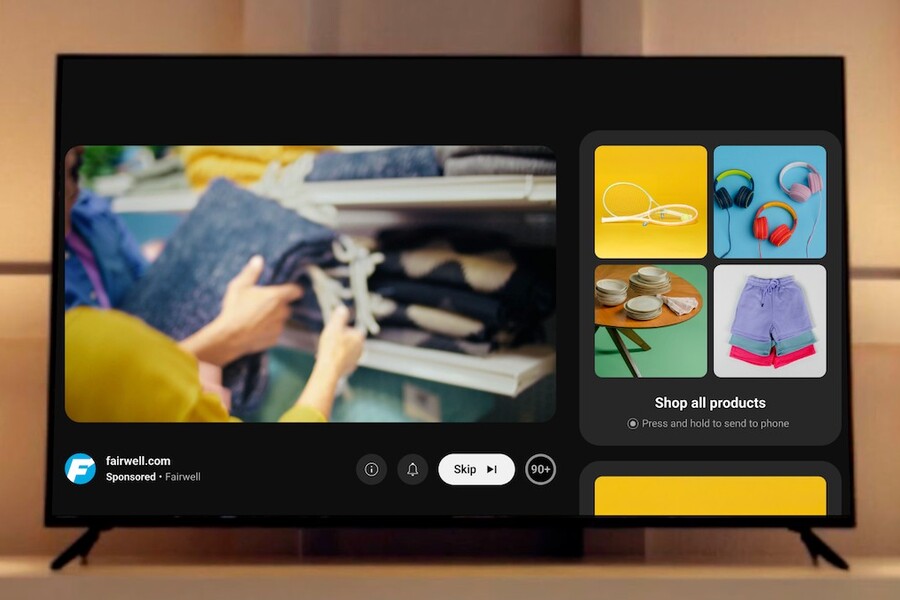In a major move to redefine its role in connected TV and digital advertising, YouTube rolled out a series of new features and partnerships during its annual Brandcast Upfront presentation in New York. The Google-owned video giant introduced shoppable ads for connected TVs, unveiled a groundbreaking AI-driven ad placement feature called “Peak Points,” and announced a landmark NFL streaming partnership — all in a clear attempt to attract a larger share of traditional television ad dollars.
📺 A New Era of Shoppable TV Ads
YouTube’s biggest reveal was its interactive product feed for shoppable connected TV ads, a new format that brings online storefronts to the big screen. This feature enables advertisers to display a sidebar of clickable products alongside their commercials, giving viewers the option to browse multiple items using their remotes.
When a product is selected, a QR code appears, allowing users to instantly continue the shopping experience on their smartphones. There’s also an option to send a product collection to their phone for later browsing — a nod to modern second-screen behaviors.
This upgrade positions YouTube as a frontrunner in the growing “shoppable TV” trend, joining competitors like Amazon Prime Video, which also recently introduced interactive ad formats that highlight customer reviews and Prime delivery benefits.
🤖 Emotion-Aware Ads: Introducing “Peak Points”
YouTube is also betting on emotion-based ad targeting with its new “Peak Points” feature. Leveraging Google’s Gemini AI, the platform analyzes videos in real time to identify high-emotion, high-engagement moments, such as a viral marriage proposal or dramatic finale, and inserts ads immediately afterward.
The theory is simple but powerful: viewers are more likely to remember ads when their emotional engagement is at its peak. While this may raise concerns about interrupting user immersion, it also opens a new frontier for brands aiming to align with compelling content in real time.
🏈 YouTube Scores with NFL Friday Game and Creator “TV Shows”
In another major announcement, YouTube revealed that it will exclusively stream the NFL’s first-ever Friday night game of the 2025-2026 season, hosted in São Paulo, Brazil. The match will be available globally and marks the first time YouTube is broadcasting an NFL game live — a major step in YouTube’s effort to present itself as the new face of live sports broadcasting.
This expansion follows YouTube’s successful airing of the Super Bowl LIX Flag Football game, which attracted over 6 million live views. YouTube also says it will continue streaming the NFL Flag Football game in future seasons.
To capitalize further on living room viewership, YouTube is launching a pilot program for creators to package their content into “bingeable TV shows” with organized seasons and episodes. Hundreds of creators, including Michelle Khare and the duo behind Good Mythical Morning, will participate in the U.S. rollout this summer.
CEO Neal Mohan emphasized that creators earning revenue from TV screens grew by over 30% year-over-year, underscoring YouTube’s evolving identity from a social video platform to a TV-centric content hub.
📊 Why It Matters
This suite of innovations clearly illustrates YouTube’s strategy: it no longer wants to be seen merely as a digital platform. It aims to be the next-generation TV network — one that’s data-rich, AI-powered, creator-driven, and commerce-integrated.
- Ad Effectiveness: With YouTube campaigns on CTV generating more than 50 million average monthly conversions in Q4, the new features are expected to boost those numbers even higher.
- Platform Dominance: According to Nielsen, YouTube has held the No. 1 position for streaming watch time in the U.S. for over two years, outperforming Netflix, Disney+, and Prime Video.
- Brand Discovery: A Kantar survey cited by YouTube showed that users rank the platform as the top destination for researching brands.
🎤 Flash and Influence: Brandcast Highlights
The presentation featured performances and appearances by major entertainers and influencers, including Lady Gaga, Brittany Broski, and MrBeast, adding celebrity dazzle to the tech-focused event. Brand case studies from companies like Volvo, Hilton, and State Farm reinforced YouTube’s pitch to advertisers.
📈 The Bigger Competitive Picture
Other platforms are not standing still. Netflix, for example, is expanding its live streaming portfolio with events like the NFL Christmas Day games, the Screen Actors Guild Awards, and WWE matches. It also introduced a generative AI ad placement feature and first-party data integrations, aiming to better compete in targeted advertising.
Meanwhile, Amazon is expanding ad-supported Prime Video to India and promoting add-on subscriptions for an ad-free experience — a model that has already attracted 130 million viewers in the U.S.
And in a reversal of branding strategy, Warner Bros. Discovery will rebrand Max back to HBO Max, acknowledging that the original change failed to resonate with viewers and advertisers alike.
🔮 What’s Next?
For YouTube, the future seems to revolve around three pillars:
- TV-like experiences: Structuring content like traditional shows while maintaining the flexibility of digital.
- Commerce-driven advertising: Blurring the lines between content and commerce with real-time shoppable formats.
- AI-enhanced targeting: Using machine learning to make smarter ad placements that feel seamless to viewers.
With these moves, YouTube is effectively rewriting the rulebook on what a streaming platform can be — not just an entertainment destination, but a fully integrated ecosystem for content, commerce, and conversion.
📌 Key Takeaway for Viewers and Marketers
YouTube is transforming from a video-sharing platform into a TV powerhouse where shopping, watching, and interacting converge. For brands, it offers powerful new tools to meet audiences where they are — on their couches, with remotes in hand. For viewers, it could mean a more immersive (albeit ad-laden) entertainment experience that feels tailored to their tastes, habits, and emotions.
If YouTube continues to innovate at this pace, the term “watching TV” might soon be synonymous with streaming YouTube.


